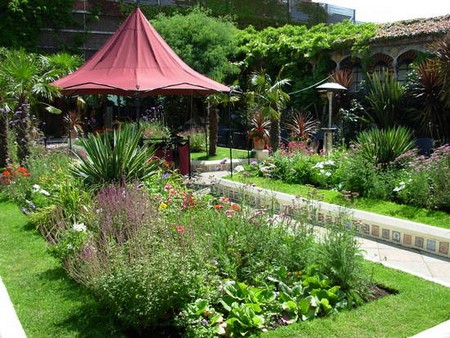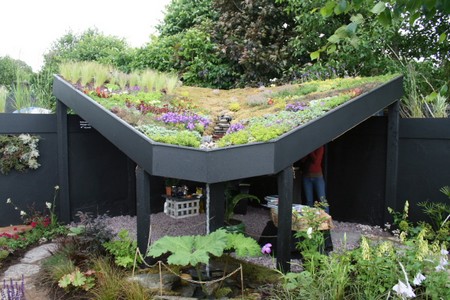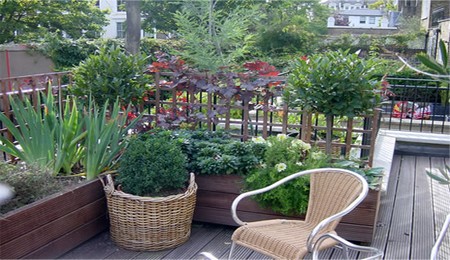A formal roof garden elevates the gardener heavenward and makes the most of a small, sunny area. From being a potentially dull, overlooked and boring corner, the area has been turned into a beautiful and restful garden, far above the busy streets, where you can escape, entertain and relax.
Because of the sunny, light conditions, a roof garden is the ideal place for plants that might otherwise be difficult to grow. Once there is protection from the wind you can grow a far wider range of plants than you might imagine.
The important principals that apply to roof gardens can equally be applied to verandas and balconies.
Features
One of” the most important points to bear in mind when considering a roof garden is that the weight of the features, such as borders filled with moist compost and, as here, a small pool, will be enormous. Before embarking on such a garden, have a structural survey carried out. In this particular design, keeping the planting and structures near to the sides means that the most weight is as close to the weight-bearing structures of the building as possible, but a proper survey will identify any potential problems.
The materials used in this scheme link the house and garden so that the garden feels like an extension of the living area – which, of course, it is.
The uniform rectangular pavers are simple and with uncluttered lines. The planting is limited mostly to the raised beds, which are made from the same pavers as those used to cover the floor to avoid detracting from the spacious feel created by keeping the main area bare. Cleverly, the raised beds also form low walls along two sides of the garden, giving additional shelter and privacy. If your roof could not bear the weight of pavers, consider using artificial grass as a floor covering. It is much lighter and will add uniform colour.
The ingenious inclusion of the chimney-stack as a focal feature is a brilliant way of avoiding losing space by having to build a structure to hide it. In a limited space such as this, every feature, unless it is very unsightly, should be incorporated into the design. The chimney itself brings the raised beds nicely inwards to create a particularly stylish background to the pool.
A lot of space for plants has been created by using raised beds and slatted fencing. The wide-spaced slats allow light through while effectively enclosing the previously open side of the garden. The fence also hides an ugly view and defines the boundary, and it blends well with the mature brickwork of the chimney. The advantages of a slatted fence like this are that it provides privacy and offers some protection from the elements but it is not very heavy.
Shade is provided by a wooden pergola, made from wooden slats similar to the wood used for the fence, and this is covered with flowering climbers. The trellis on the wall and a planting hole make it possible to have climbers growing up and over the structure, making a private, shaded spot for sitting out. The simple furniture is wooden to bring more wood into the garden, reflecting the materials used for the fence and pergola and adding warmth and a natural feel.
The formal pool provides a large area of smooth water, which will mirror the sky and the clouds. Light playing on its surface will introduce movement, changes in colours and gentle noise. The elegant statue adds drama and style to the garden without dominating it. The choice of a bird has been carefully thought about, and it hints at a sense of freedom and power. The small fountain adds movement and will create ripples on the water’s surface.
To extend the use of the roof garden, a lighting system could be installed. A small area like this would need a very simple system, but the effect would be instantaneous and you would have an extra room for much of the year. A light in the pool would also highlight the statue and bring the pool into relief during the hours of darkness. The interplay of light and water after dark is mesmerizing, and lighting would also, of course, make the roof garden a safer place at night.
An irrigation system could be used to make sure that the plants get adequate water and reduce the need for daily watering. Care should, however, be taken that excess water can drain away so that it does not seep through into the floors below.
Planting
Keeping the plants largely confined to the edges creates a sense of space in the centre, but the plants also play a part in providing protection from the elements and help to break up the potentially stark lines of the masonry. The diversity of the foliage provides the lush green normally provided by a lawn.
The largely evergreen shrubs will give year-round interest, and they are interspersed with a few fragrant plants that will flower over a long period and help to create a relaxed atmosphere.
Using plants that have slender, erect stems will add to the formal feel of this garden, and an unusual blue buddleia, Buddleja davidii ‘Empire Blue’, will look attractive in this setting. Plants that have grass-like foliage, such as Luzula sylvatica ‘Aurea’ and Phalaris arundinacea var. picta ‘Feesey’, will add to the visual impact and softly reflect the colours of the water and sky. Wind-tolerant plants will provide interest all year round and there are more plants than you might expect that will thrive in the sunny, windy conditions that are to be found on a roof.
Categories
Advertisements
Recent Articles
 How to Understand Bed Sizes – A Small Guide
How to Understand Bed Sizes – A Small Guide How to Select Some Must Have Kitchen Accessories
How to Select Some Must Have Kitchen Accessories Best Way to Change a Car Tire
Best Way to Change a Car Tire Best Way to Write an Affirmation
Best Way to Write an Affirmation Best Way to Take Charge of Your Financial Life
Best Way to Take Charge of Your Financial Life Best Way to Survive a Party When You Don’t Know Anyone
Best Way to Survive a Party When You Don’t Know Anyone Best Way to Stop Self Sabotaging Yourself
Best Way to Stop Self Sabotaging Yourself Best Way to Start Journal Writing
Best Way to Start Journal Writing Best Way to Speak with a Powerful Voice
Best Way to Speak with a Powerful Voice Best Way to Simplify Your Life
Best Way to Simplify Your Life Best Way to Respond to a Put-Down
Best Way to Respond to a Put-Down Best Way to Reduce Acne Breakouts
Best Way to Reduce Acne Breakouts Best Way to Recover from Dining Disasters
Best Way to Recover from Dining Disasters Best Way to Quit Your Job Gracefully
Best Way to Quit Your Job Gracefully Best Way to Make Your Own Website
Best Way to Make Your Own Website




Leave a Reply